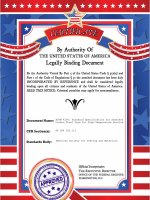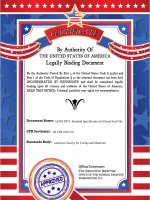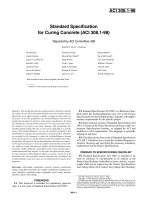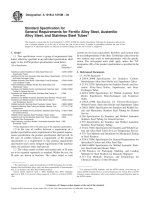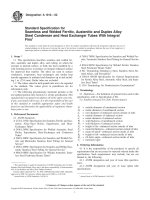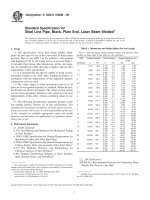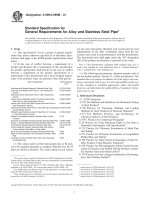ASTM D83-84 (2020) Standard Specification for Red Lead Pigment
Bạn đang xem bản rút gọn của tài liệu. Xem và tải ngay bản đầy đủ của tài liệu tại đây (67.75 KB, 2 trang )
This international standard was developed in accordance with internationally recognized principles on standardization established in the Decision on Principles for the
Development of International Standards, Guides and Recommendations issued by the World Trade Organization Technical Barriers to Trade (TBT) Committee.
Designation: D83 − 84 (Reapproved 2020)
Standard Specification for
Red Lead Pigment1
This standard is issued under the fixed designation D83; the number immediately following the designation indicates the year of original
adoption or, in the case of revision, the year of last revision. A number in parentheses indicates the year of last reapproval. A superscript
epsilon (´) indicates an editorial change since the last revision or reapproval.
1. Scope True red lead (Pb3O4), min, %: 85
85 % grade 95
1.1 This specification covers four grades of red pigment 95 % grade 97
commercially known as red lead. The pigment may be pur- 97 % grade 98
chased in the dry form or as a paste in oil. 98 % grade 1.0
1.2 The values stated in inch-pound units are to be regarded Total impurities including moisture, water soluble remainder
as standard. The values given in parentheses are mathematical matter, and matter insoluble in a mixture of 1.0
conversions to SI units that are provided for information only nitric acid and hydrogen peroxide, max, %
and are not considered standard.
Lead monoxide, PbO
1.3 This international standard was developed in accor- Coarse particles (total residue retained on a 45-µm
dance with internationally recognized principles on standard-
ization established in the Decision on Principles for the (No. 325) sieve), max, %
Development of International Standards, Guides and Recom-
mendations issued by the World Trade Organization Technical When mixed as indicated in the following table, the resulting
Barriers to Trade (TBT) Committee. paint, brushed on a smooth vertical iron surface, shall dry hard
and elastic without running, streaking, or sagging:
2. Referenced Documents
2.1 ASTM Standards:2 Dry red lead 20 lb (9.1 kg)
D49 Test Methods of Chemical Analysis of Red Lead Raw linseed oil 5 pt (2.4 L)
D185 Test Methods for Coarse Particles in Pigments Turpentine 2 gills (0.24 L)
D1208 Test Methods for Common Properties of Certain Liquid drier 2 gills (0.24 L)
Pigments
3.2 Paste in Oil—The paste shall be made by thoroughly
3. Composition and Properties grinding the specified pigment with linseed oil (Note 1). The
paste as shipped by the seller, and for three months thereafter,
3.1 Dry Pigment—The pigment shall be made by roasting shall not be caked in the container, and shall break up readily
litharge or metallic lead, or compounds of lead that yield in oil to form a smooth paint of brushing consistency. The paste
litharge by heating, and shall consist entirely of oxides of lead, shall conform to the following requirements:
free of adulterants. The four grades of pigment shall conform
to the following requirements: Pigment, % 92 to 94
Linseed oil, % 6.0 to 8.0
1 This specification is under the jurisdiction of ASTM Committee D01 on Paint Moisture and other volatile matter, max, % 0.5
and Related Coatings, Materials, and Applications and is the direct responsibility of Coarse particles and skins (total residue retained on 1.5
Subcommittee D01.31 on Pigment Specifications.
a No. 325 (45-µm) sieve), max, % of the dry pigment
Current edition approved June 1, 2020. Published June 2020. Originally
approved in 1921. Last previous edition approved in 2014 as D83 – 84 (2014). DOI: When mixed as indicated in the following table, the resulting
10.1520/D0083-84R20. paint, brushed on a smooth, vertical iron surface, shall dry hard
and elastic without running, streaking, or sagging:
2 For referenced ASTM standards, visit the ASTM website, www.astm.org, or
contact ASTM Customer Service at For Annual Book of ASTM Red lead paste 20 lb (9.1 kg)
Standards volume information, refer to the standard’s Document Summary page on Raw linseed oil 3 pt (1.4 L)
the ASTM website. Turpentine 2 gills (0.24 L)
Liquid drier 2 gills (0.24 L)
NOTE 1—The storage of paste red lead in places of high temperature
should be avoided, as heat accelerates the tendency of this material to cake
or harden. Purchasers are cautioned that 85 % grade red lead should not be
bought in paste form. The 95 % grade, if made into paste, should be used
within a short period of time after grinding. When pure red lead paste is
to be stored for a considerable period of time, the 97 % or 98 % grade of
red lead should be specified. Therefore the manufacturer shall identify the
grade of red lead used in the paste and the date of manufacture.
Copyright © ASTM International, 100 Barr Harbor Drive, PO Box C700, West Conshohocken, PA 19428-2959. United States
D83 − 84 (2020)
4. Sampling test methods shall be mutually agreed upon between the
purchaser and the seller.
4.1 Two samples shall be taken at random from different
packages from each lot, batch, day’s pack, or other unit of 5.1.1 Chemical Analysis—Test Methods D49.
production in a shipment. When no markings distinguishing 5.1.2 Coarse Particles—Test Methods D185.
between units of production appear, samples shall be taken 5.1.3 Pigment, Linseed Oil, and Moisture and Other Volatile
from different packages in the ratio of two samples for each Matter in Paste in Oil—Test Methods D1208.
10 000 lb (5000 kg), except that for shipments of less than
10 000 lb two samples shall be taken. At the option of the 6. Keywords
purchaser, the samples may be tested separately or after 6.1 lead oxide; lead tetra oxide; pigment; red lead
blending in equal quantities the samples from the production
unit to form a composite sample.
5. Test Methods
5.1 Tests shall be conducted in accordance with the follow-
ing ASTM test methods. Test procedures not covered by ASTM
ASTM International takes no position respecting the validity of any patent rights asserted in connection with any item mentioned
in this standard. Users of this standard are expressly advised that determination of the validity of any such patent rights, and the risk
of infringement of such rights, are entirely their own responsibility.
This standard is subject to revision at any time by the responsible technical committee and must be reviewed every five years and
if not revised, either reapproved or withdrawn. Your comments are invited either for revision of this standard or for additional standards
and should be addressed to ASTM International Headquarters. Your comments will receive careful consideration at a meeting of the
responsible technical committee, which you may attend. If you feel that your comments have not received a fair hearing you should
make your views known to the ASTM Committee on Standards, at the address shown below.
This standard is copyrighted by ASTM International, 100 Barr Harbor Drive, PO Box C700, West Conshohocken, PA 19428-2959,
United States. Individual reprints (single or multiple copies) of this standard may be obtained by contacting ASTM at the above
address or at 610-832-9585 (phone), 610-832-9555 (fax), or (e-mail); or through the ASTM website
(www.astm.org). Permission rights to photocopy the standard may also be secured from the Copyright Clearance Center, 222
Rosewood Drive, Danvers, MA 01923, Tel: (978) 646-2600; />
2
